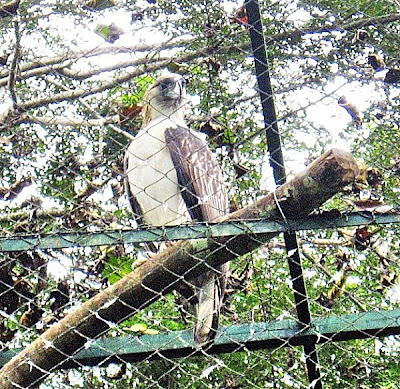 |
| A tiger bathing in a pond |
After an overnight stay at Subic Yacht Club with my son Jandy, we proceeded, after a Chowking lunch and duty-free shopping at the Freeport Exchange, for a short-haul drive to this sprawling 25-hectare Zoobic Safari theme park and zoo located deep in the old Naval Magazine at the Jungle/Forest Adventure zone. Upon arrival, we were welcomed by Gen. Manager Ms. Delia C. De Jesus who assigned to me the affable Mr. Noel Caneda to guide me on this 2-hr., 5-part tour. He explained to us the different species that can be found inside the park, extolling their virtues as well as their deadly qualities.
 |
| Noel Caneda feeding a camel |
At the reception area, we already got to see adult and baby tigers in large cages, all crossbred from Bengal and Siberian varieties in Residence Inns’ tiger cub breeding facility. A joint venture with Subic Bay Metropolitan Authority (SBMA), the PhP80 million Zoobic Safari was opened to the public on November 2004 and is part of Residence Inn’s chain of zoo cum resort businesses. The animals here may not be all originally from the Philippines but the place was still developed with a Filipino theme in mind.
Our first stop was the Petting Zoo a path through a forest with different animals stationed on the both sides of the walkway. Here we saw exotic animals such as deer, temperamental and territorial cassowary, bearcats, monkeys, mini horses, several rabbits, plus some farm animals such a number of goats, sheep, carabao, pigs and a pinkish albino cow, all roaming and frolicking about in their natural habitat. Jandy and I had a wonderful time petting and feeding dried leaves to a camel. A close encounter with an Asiatic black bear (or moon bear) named Nicholas, the only one in the zoo (and thus lonely), was a highlight. Other stops include the Serpentarium, the only one of its kind in the country. Housed in one of the former ammunition bunkers, it showcases a variety of reptiles including a Malaysian water monitor, blood pythons, a Burmese albino, reticulated python, the Philippine monitor lizard, iguanas and turtles. The star here was “Biggy,” a 15-ft. long, 10 year old female Indian python.
 |
| An Asiatic black bear named Nicolas |
The highlight of the tour was the Tiger Safari. Here, we boarded a customized “safari” jeepney colorfully painted in tiger-inspired golden stripes and enclosed with one inch, open wire mesh which covered the windows and doors. It was driven by a professional Aeta who drove us, through a gate, to the well-kept Ilanin forest (although a number of big trees were uprooted due to typhoon Milenyo) where four full grown, 500+ pound tigers, with their trademark rust orange and black stripes, were roaming around. Most lazed about in a large pond, their deep-set, golden eyes staring back at us, probably wondering why we were “caged” inside our vehicle while they were roaming freely in the open. During the ride, one of the guides inside our vehicle dangled a dressed chicken from a small window. On instinct, one of the tigers ran over to the vehicle and grabbed the chicken, an encounter so close you can really see his teeth. Another tiger jumps on the roof.
 |
| Tiger’s Den |
After the Tiger Safari, we all dropped by the “Tigers Den” where we got up close and personal, along a narrow aisle, with tigers inside their cages, barely two feet away from these awe-inspiring beasts christened with such cute names as Cynthia, Gimo, Jana, Krishna, Nasha, Nico, Sharon and George. The last named, a mammoth Alpha male and the oldest at 16 years, is the acknowledged leader of the pack and king of the harem, with all of the female tigers his for the taking. Noel explained that a tiger’s urine smell marks his territory.
 |
| A fleet-footed ostrich |
Adjacent to the Tigers Den is the dusty Savannah Trail. This we traversed via an open, red and blue Zoobic Safari train (with 20-30 seating capacity), watching 50 long-legged ostriches from Africa and Australia as well as potbellied pigs, swift mountain goats, wild boar (from the USA, Vietnam and the Philippines) and 200 guinea fowl (from Papua New Guinea) glide past our vehicle. Next stop was the Animal MuZOOeum, housed in another former ammunition bunker. This interesting and educational tour features a rare collection of real stuffed animals and skeletons.
Our last stop was the Croco Loco section. Here, we trekked, via the Aeta Trail, to an Aeta Village where a group of Aetas performed, to the delight of the tourists, the dragonfly dance and a war dance, both accompanied by an Aeta guitarist. Of course, we also went to the 3,000 square meter Crocodile Farm, again seeing up close and personal, in their carefully designed natural habitat, 200 of these thick-skinned, long-bodied carnivorous saltwater crocodiles from Palawan. In the future, Zoobic Safari has plans to expand with Elephant World, Honey Bee Farm, Alligator Land and the Rice Wine Brewery.
 |
| Aetas performing a war dance |
Zoobic Safari: Group I, Ilanin Forest, Subic Bay Freeport Zone. Tel: (047) 252-2272. Fax: (047) 252-2272. Website: www.zoobic.com.ph. Entrance fee is PhP295 (Monday-Thursday) and PhP395 (Friday-Sunday). Manila booking office: 3/F, Yupangco Bldg., 339 Sen. Gil Puyat Ave., Makati City. Website: www.residenceinnresorts.com.








































